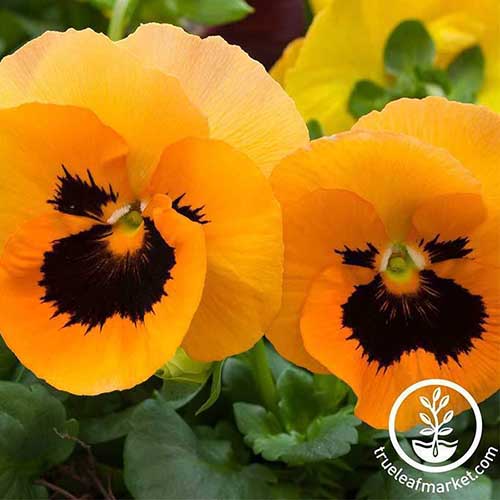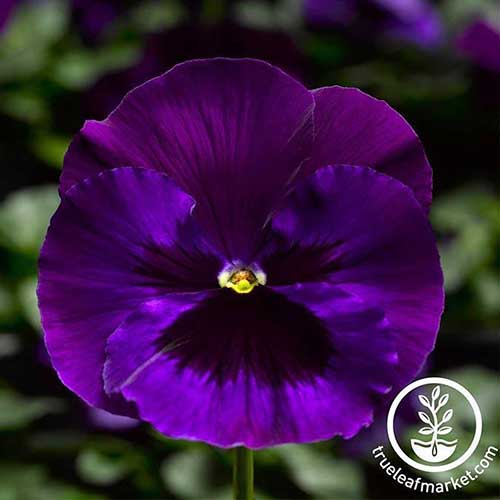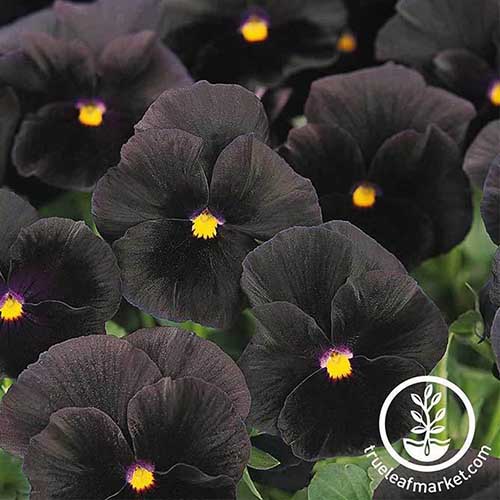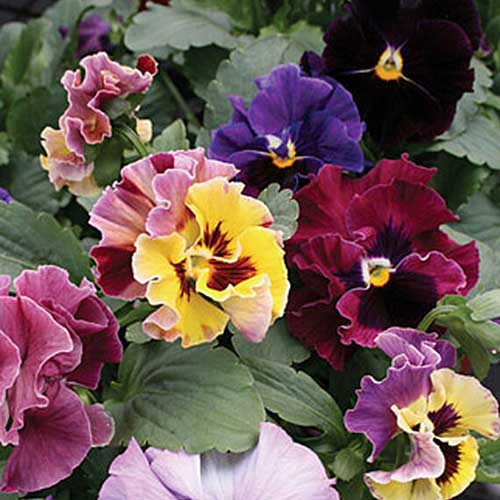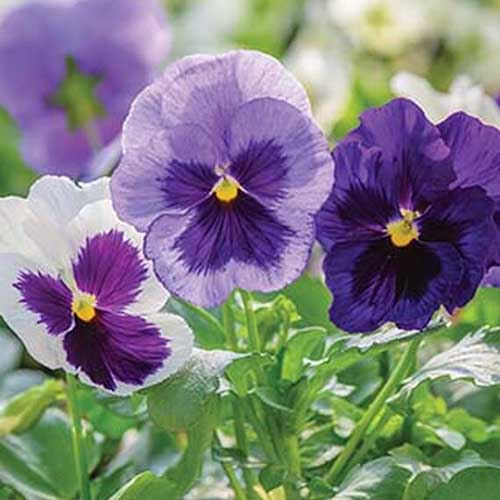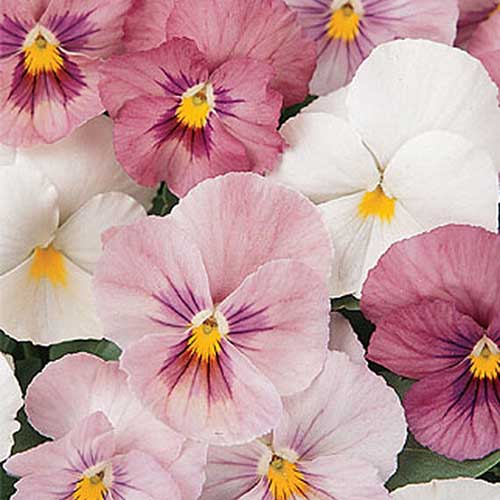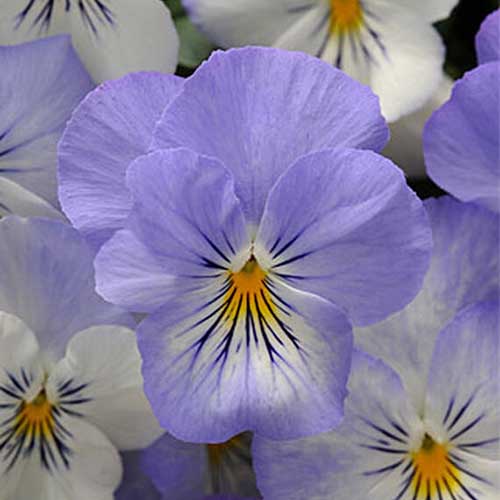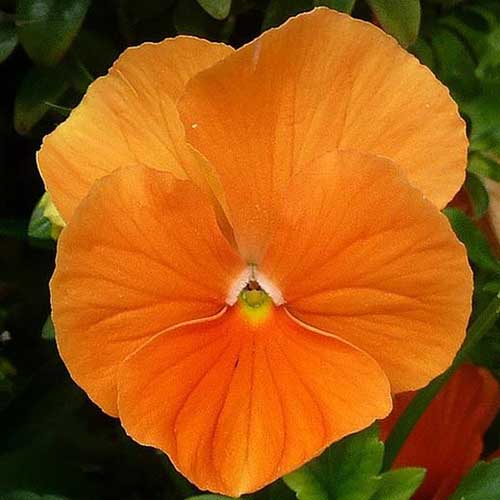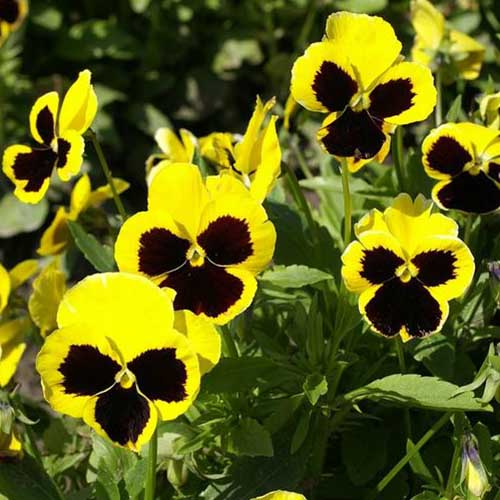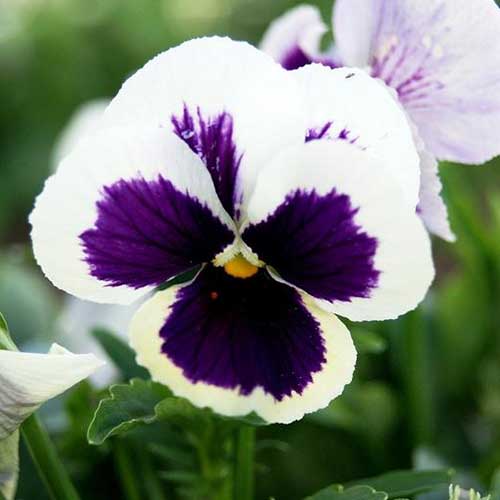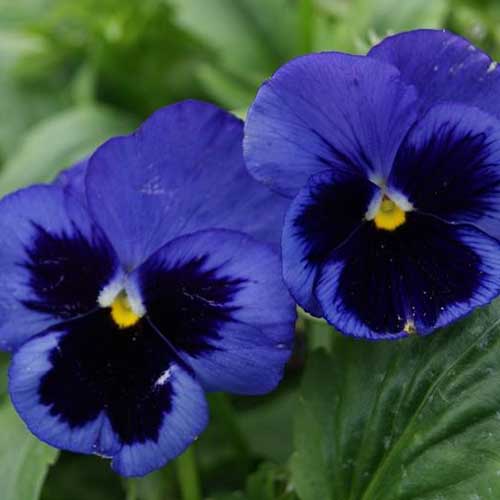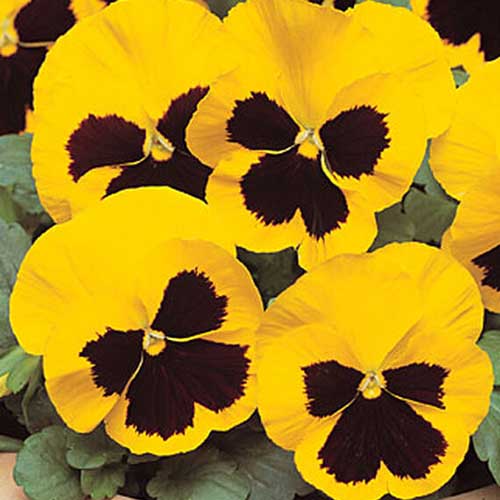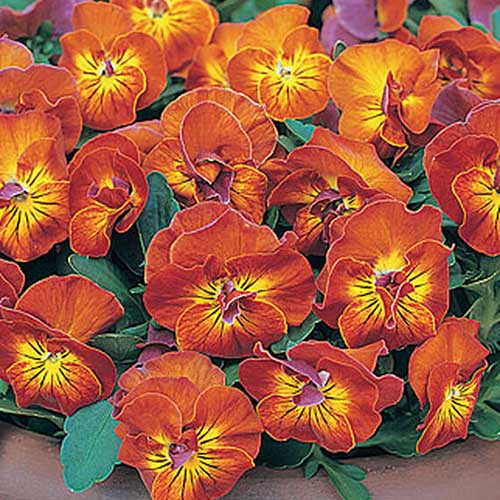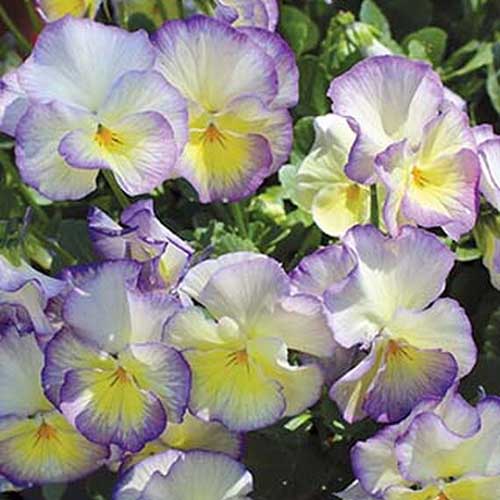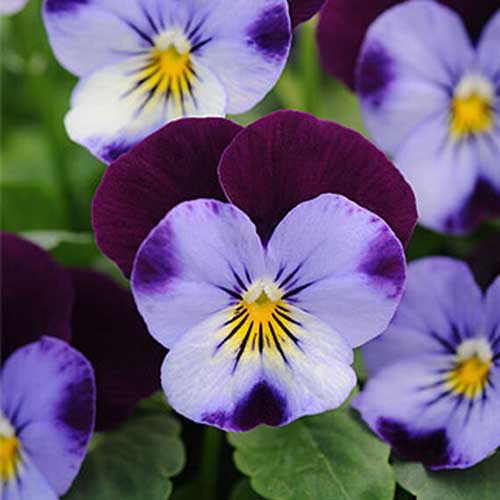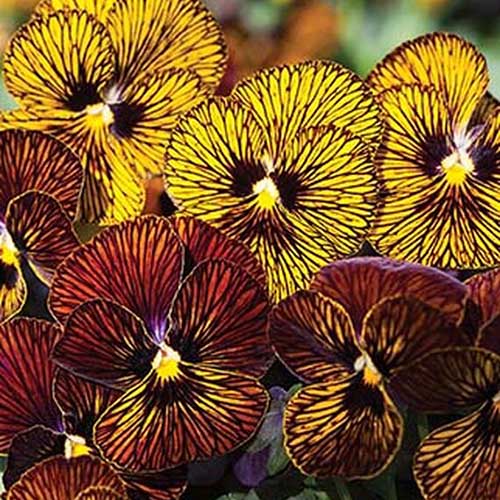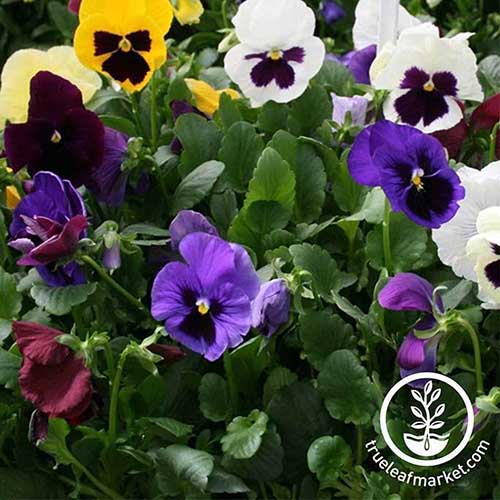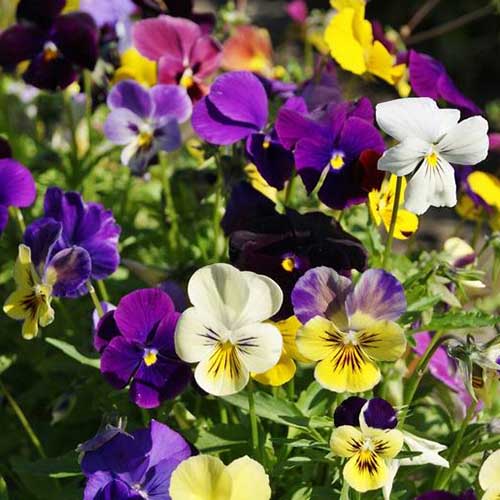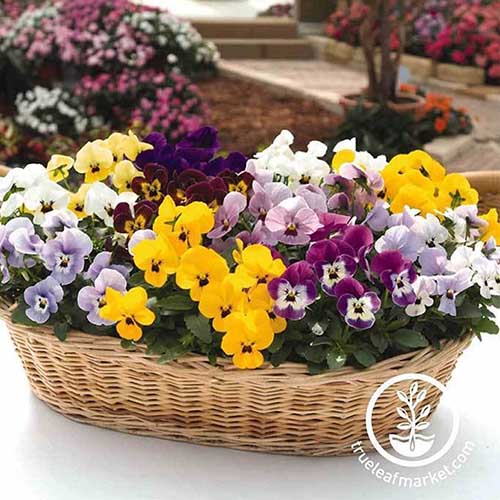I’ve never forgotten the joy of seeing tiny purple, white, and yellow ‘Johnny Jump Ups’ popping up through the soil in the springtime.
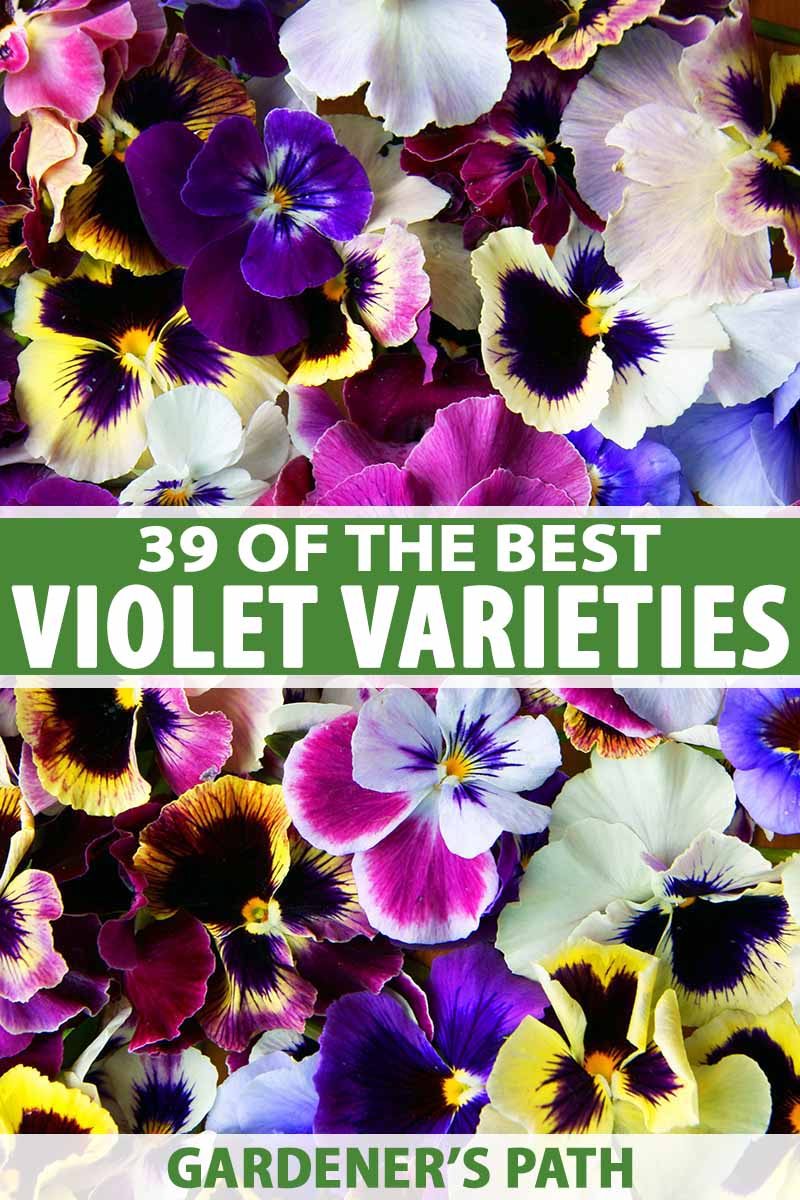
We had a clump of pansies in our flower garden in Montana when I was growing up.
I don’t know if they were wild or if we planted them there, but I do remember how much their colorful little faces cheered me up.
Recently, I’ve been in need of some cheer. So I set out to find out more about the little Johnny Jump Up and the rest of its family.
As a result of my research, I’ve got a window box of ‘Lilac Ice’ violas growing in my office. And I have discovered the most wonderful viola varieties to bring you some joy.
Let’s get started!
Violet Varieties For Your Garden
On Violets: A Primer
Violas, violets, and pansies, oh my! There’s nothing quite so perplexing as trying to figure out the difference between these three lovely blossoms.
But there are differences, and after this quick primer, you’ll know them by heart.
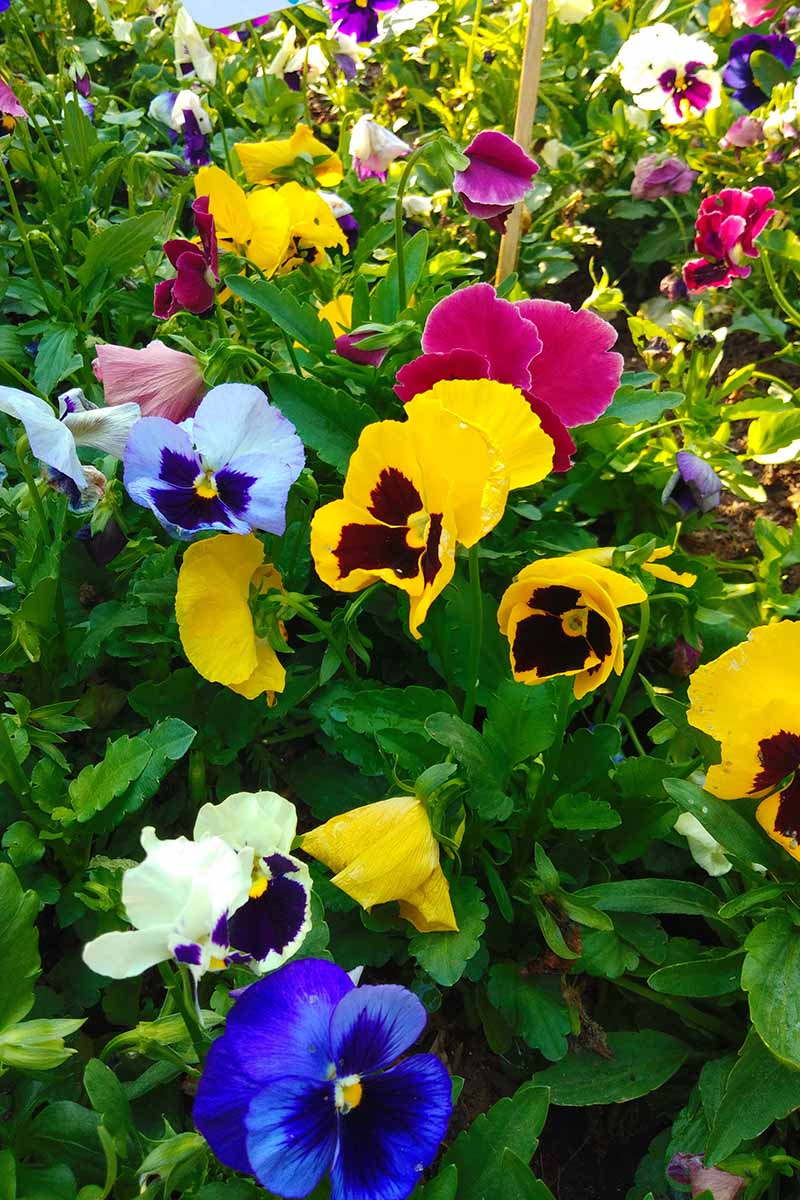
The first thing to note is that the genus Viola, part of the family Violaceae, comprises all of the species and cultivars that we call violets, violas, and pansies.
All flowers labeled “pansy” that are sold today are cultivated hybrids and subspecies of the original wild species V. tricolor – also known as Heartsease.
Cultivated enthusiastically since the 18th century, the garden pansy boasts a wide variety of colors and usually has a characteristic “blotch” on the face of the flower.
In the late 19th century, a Swedish botanist, Veit Brecher Wittrock, started crossing V. tricolor with other species such as V. lutea from Russia, and V. altacia. This gave rise to hybrids known as V. x wittrockia.
You can learn more about pansies in our growing guide.
Flowers labeled “viola” are also hybrids of V. tricolor, although many have been further crossed with other species such as V. cornuta, V. lutea, and V. striata.
These were originally cultivated in the late 19th century by James Grieve, a nurseryman at Dickson Nursery, in Edinburgh, Scotland. As a result of this work he became known as the “father of the bedding viola.”
And then there are those known as “violets,” which are the wildflowers, and encompass a number of different botanical species.
Let’s break this down so that you know how to tell them apart, beginning with pansies, which are the easiest to distinguish from the other two.
In a pansy,
- You’ll see the biggest blossoms
- Four petals point upward, one petal points down
- Blossoms will often have blotched faces
- Plants will grow from six to twelve inches tall
- Life cycle is usually annual
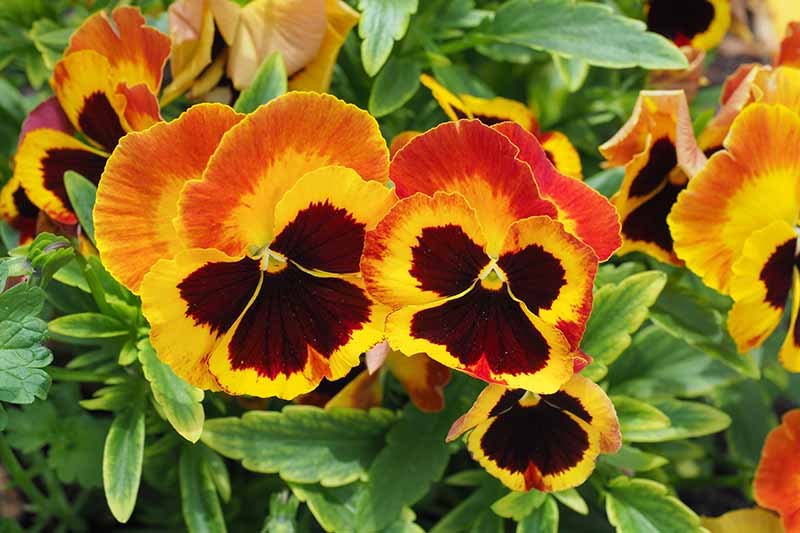
Violas, on the other hand,
- Are smaller than pansies, at 3-8 inches tall, but bigger than violets
- Have three petals pointing down and two pointing up
- Don’t often have blotched faces
- Can be annuals, biennials and sometimes perennials
Something important to note is that violas are often labeled as pansies in nurseries and garden centers. So don’t feel bad if you get a little confused.
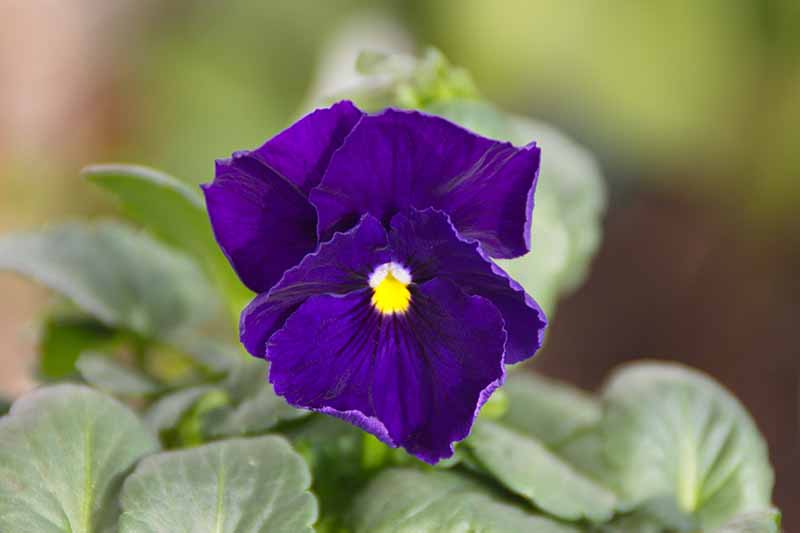
And be heartened by how easy it is to tell violets apart from pansies and violas alike.
Violets are wildflowers. And yes, you can absolutely grow them in your garden! They:
- Are much smaller than pansies or violas, each bloom measuring just an inch or so across.
- Have three petals pointing down and two pointing up
- Almost always have many more leaves than flowers
- Are perennials

Some smell sweet. Others have no fragrance at all. All are lovely to behold and have been praised in literature for centuries.
A Shakespeare sonnet from 1584 reads,
Violet is for faithfulness
Which in me shall abide
Hoping likewise that from your heart
You will not let it slide.
Ah, the faithful violet! Tiny, sweet-scented in the case of V. odorata, which you’ll learn about below, and delicately gorgeous.
They make a stunning statement in any garden, and with our 39 varieties (plus three extra mixes, if you can’t quite decide on your favorite), you’re sure to find more than one to suit your fancy.
The 39 Best Violet Varieties
For your convenience, we’ve divided this roundup into three parts according to each type of Viola.
We’ll begin with flashy, colorful pansies before moving on to the more delicate violas, and finishing with the wildflower violet species. We’ve also added links to our trusted affiliates where you can purchase seeds or transplants.
Pansies
Pansies are an excellent choice for your garden with their bright array of colors and large, velvety blooms.
Most pansies are at least bicolored, and many boast three stunning shades on each blossom.
Pansies prefer either full sun or partial shade. They are annuals unless otherwise specified. If you are growing them from seed, for best results you’ll want to sow them indoors in loose, well-draining soil for transplant into the garden.
1. Delta
Delicate in bloom but bold in color, the Delta series (V. x wittrockiana) is a hybrid series to suit any pansy grower’s fancy.
series (V. x wittrockiana) is a hybrid series to suit any pansy grower’s fancy.
You can find these two-inch tri-colored blooms in signature colors including ‘Pure Lemon,’ ‘Pure Red,’ ‘Orange Blotch,’ and ‘Neon Violet.’
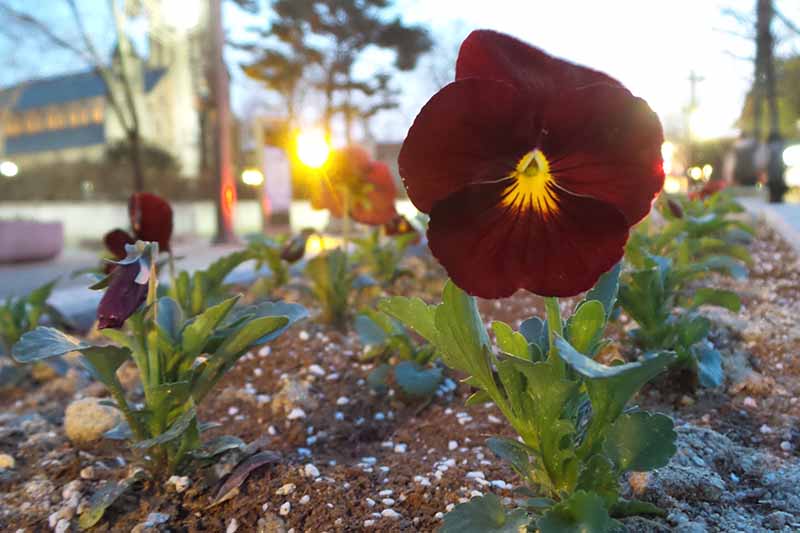
 ‘Pure Red’
‘Pure Red’They mature into a four- to six-inch tall mound and spread six to eight inches, making them a nice choice for a window box or walkway.
As a dwarf variety, cultivars of the Delta series are apt to let other flowers soar above the glorious blooms, stealing precious sunshine.
series are apt to let other flowers soar above the glorious blooms, stealing precious sunshine.
Hardy to USDA Zones 4-10, these flowers will thrive in moist yet well-drained soil.
Sow seeds indoors 12-14 weeks before your average last frost date and they’ll stun you with their colorful blooms in 91-98 days.
Pansies in this series bloom in the early spring and through the summer. In warmer zones, this annual keeps producing brilliant new flowers all through the fall and winter, too.
Find packets of 500 seeds in your chosen color, or as a mix of colors at True Leaf Market.
2. Halloween II
A huge, inky-black bloom, ‘Halloween II’ (V. x wittrockiana) makes a perfect addition to your October decor.
It’s hardy to USDA Zones 4-10 and spreads its delicious spookiness in an eight- to 10-inch mound.
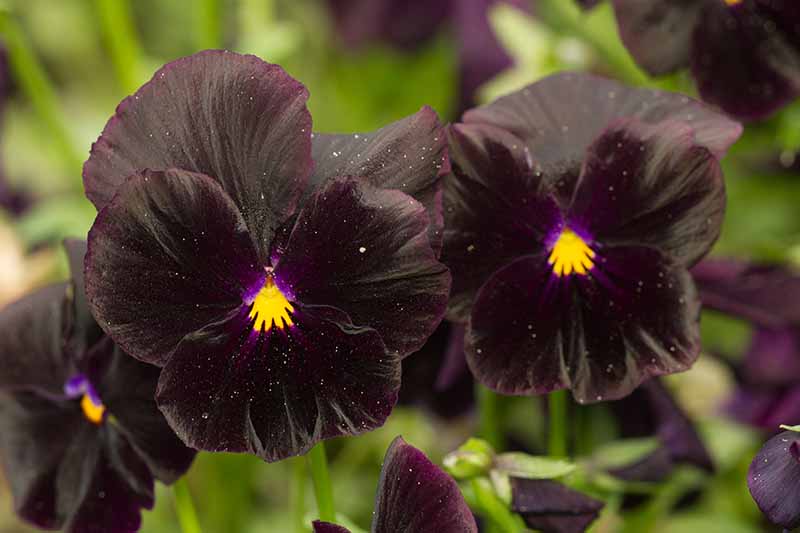
With three-inch flowers and purple-tinged yellow eyes, ‘Halloween II’ might just be the most thrilling pansy of all. It also might steal all the attention away from your other flowers.
This cold-hardy cultivar grows six to eight inches tall and loves moist, well-drained soil.
Sow seeds 12-14 weeks before your average last frost date for blooms that keep coming into Halloween-time and beyond.
Packets of 500 seeds are available from True Leaf Market.
3. Mammoth
With three- to four-inch flowers, the Mammoth series (V. x wittrockiana) truly earns its name.
The large, flat tri-colored blooms grow six to eight inches tall and spread six to eight inches wide, and they’re a little less cold hardy than other cultivars, thriving in Zones 5-9.
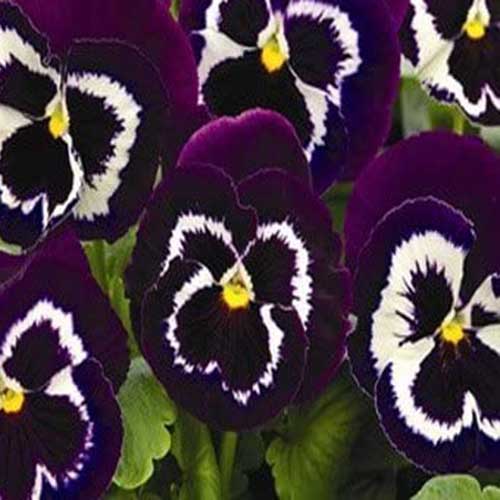
With shades in berry, deep violet, and white flowers from the Mammoth series are pleasing to the senses and soul.
Find packets of 50 to 100 seeds from Outsidepride via Amazon.
4. Matrix
Available in a variety of colors from scarlet to light blue to orange, the Matrix series (V. x wittrockiana) produces three- to three-and-a-half-inch flowers.
series (V. x wittrockiana) produces three- to three-and-a-half-inch flowers.
Some are solid colored. Others feature two shades. Still others are classic tricolor blooms.
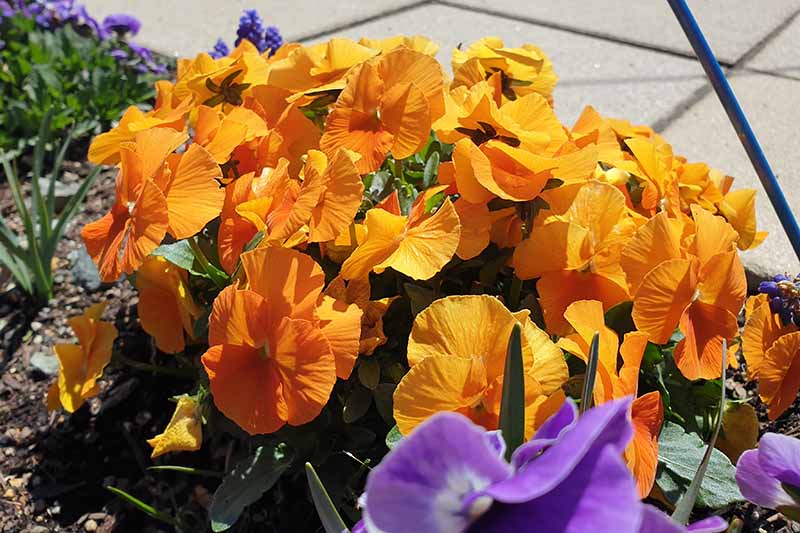
With a spread of six to eight inches wide and six to eight inches tall, Matrix cultivars won’t overtake your garden – but they will turn heads with their deep, radiant colors and dozens of blooms per plant.
cultivars won’t overtake your garden – but they will turn heads with their deep, radiant colors and dozens of blooms per plant.
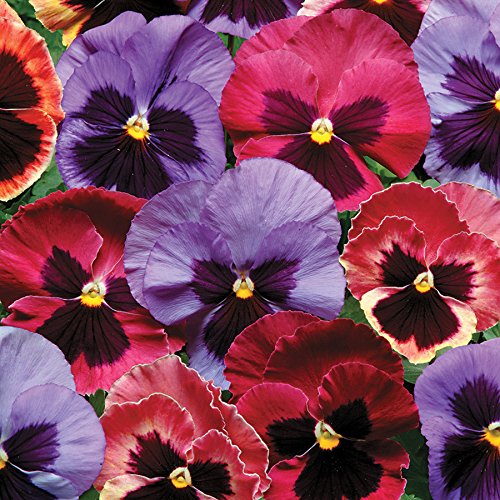
Matrix has unusually strong branches and blooms prolifically from early spring through summer.
Seeds are available from Park Seed via Amazon.
5. Moulin Rouge
This is my favorite V. x wittrockiana cultivar yet. There’s something about the ruffled leaves that remind me of a flamenco dancer’s dress.
And with an eight to ten inch spread and an eight-inch height, ‘Moulin Rouge’ is as full as a dancer’s skirt, too.
But this hybrid cultivar isn’t from Spain – it’s Italian born and bred.
The tri-colored blooms are available in blue, purple, red, and yellow and grow two and a half inches wide.
Sow indoors in moist, well-draining soil 10-12 weeks before the average last frost date and enjoy blooms through the fall, winter, and spring.
Since ‘Moulin Rouge’ is only hardy to Zones 8-11, it’s a nice choice for indoor container growing in colder areas. Those in warmer climates can enjoy blooms year-round.
Find packets of 35 seeds available at Burpee.
6. Ocean Breeze
These tricolored light-blue and dark-violet flowers are as dazzling as ocean spray. ‘Ocean Breeze’ (V. x wittrockiana) grows eight inches tall with a spread of eight to ten inches, for a sea-like show.
Plant alongside dwarf pink snapdragons or ‘Panola Pink Shades’ for a startlingly beautiful springtime combination.
‘Ocean Breeze’ is hardy to Zones 7-10 and is available in sets of four plants from Burpee.
7. Panola Pink Shades
With myriad shades of light, sweet pink, ‘Panola Pink Shades’ (V. x wittrockiana) lives up to its name.
This plant spreads eight to 10 inches and tops out at eight inches tall, making it a perfect addition to a hanging basket.
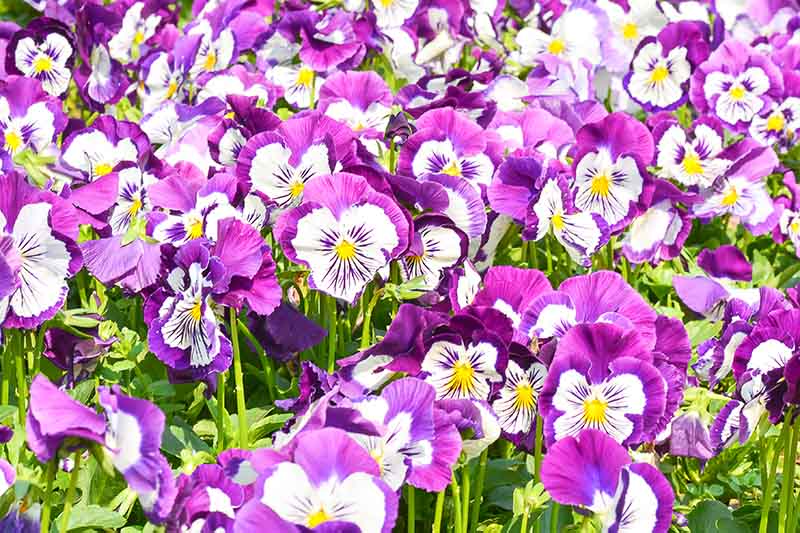
Can you imagine a basket of ‘Panola Pink Shades’ hanging in front of a blue or yellow house? It makes me smile just to think of it.
Like other pansies, seeds can be sown 10-12 weeks before the last heavy frost in your area.
They enjoy lightly moist soil, are hardy only in USDA Zones 6-8, and bloom about 70 days after sowing from seed.
You’ll enjoy blooms all the way from early spring and into the fall. Want to skip the seeds? Get a set of four plants from Burpee.
8. Plentifall Frost
Delicate and light blue like fall’s first frost, V. x wittrockiana ‘Plentifall Frost’ is another excellent choice for hanging baskets.
Perhaps even more so than any other variety, because ‘Plentifall Frost’ spills over the sides of the basket.
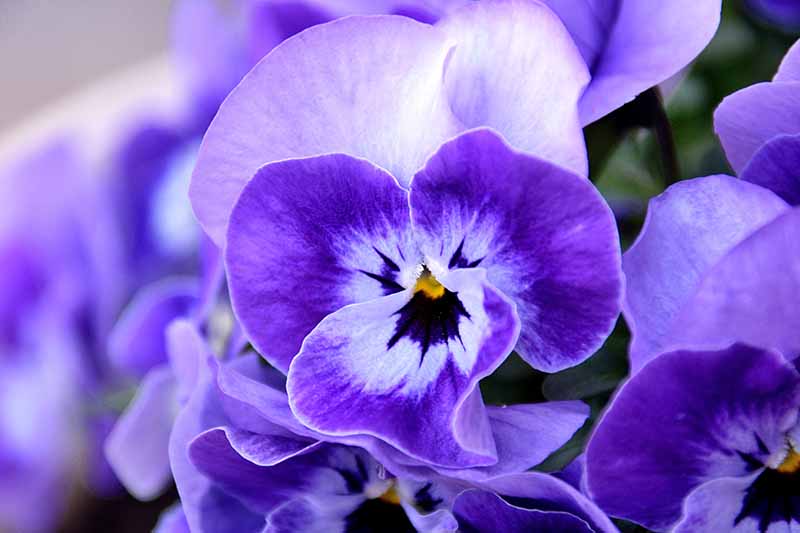
Imagine this color against a red house, like mine! Just lovely.
Though it has a large 18-24-inch spread, ‘Plentifall Frost’ only reaches six to eight inches tall, so it won’t overwhelm you if you plant it in your garden.
Sow seeds indoors 10-12 weeks before your average last frost date for a spring, summer, and fall of dainty one-inch blooms.
Or, skip the seeds and find a set of four plants at Burpee.
9. Sunrise
For a slice of sunshine at any time of the day, try ‘Sunrise,’ (V. x wittrockiana). With pink and gold petals and a 9-12 inch spread, this cultivar is sure to spark joy.
Even neater? ‘Sunrise’ pansy petals change color as they grow older. Like wine, they grow finer with age.
These plants reach a height of eight inches and bloom continuously for ten weeks.
They’re hardy to USDA Zones 4-9 and you can find a set of four plants from Burpee.
10. Swiss Giants Orange Sun
Do you like those cheerful, orange California poppies? Then you’ll love Swiss Giants ‘Orange Sun’ (V. x wittrockiana).
‘Orange Sun’ (V. x wittrockiana).
Its cheery, open face will brighten any garden. Plus, it blooms through the spring, summer, and fall – unlike poppies, which only last into early summer.
This biennial hybrid grows four to six inches tall and is hardy to USDA Zones 3-9.
Find seeds in packets of various sizes at Eden Brothers.
11. Swiss Giants Rhinegold
Want another biennial pansy to enjoy two years in a row? Then Swiss Giants ‘Rhinegold’ (V. x wittrockiana) is the cultivar for you.
‘Rhinegold’ (V. x wittrockiana) is the cultivar for you.
These bright yellow pansies have pretty dark-brown patches on three of the large petals.
Like other pansies, they enjoy moist, well-drained soil.
They grow four to six inches tall, with a spread of nine to 12 inches, bloom from the springtime to the fall, and are hardy to Zones 3-9.
You can find packets of seeds in a variety of sizes at Eden Brothers.
12. Swiss Giants Silverbride
For a flower as pretty as a bride on her wedding day, check out Swiss Giants ‘Silverbride’ (V. x wittrockiana).
‘Silverbride’ (V. x wittrockiana).
This silver-white bloom features deep purple patches that resemble a bride adorned with her flowers and lace.
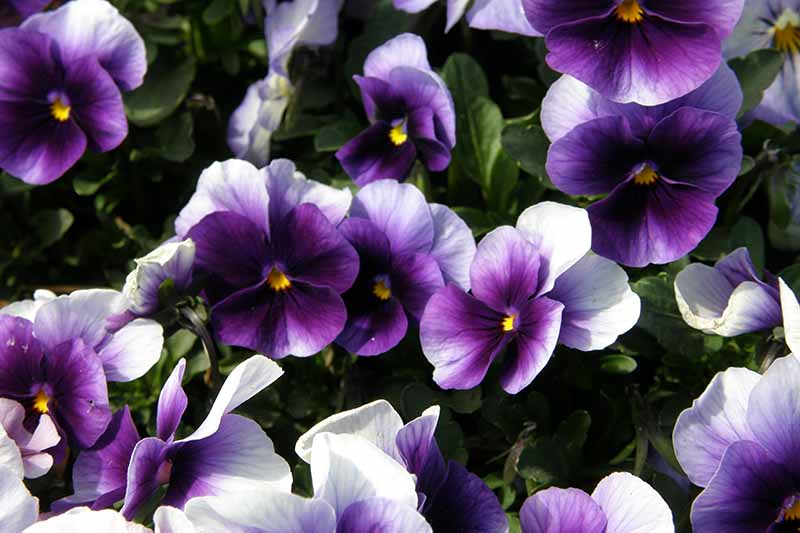
Blooming in the spring, summer, and fall, this biennial hybrid grows four to six inches tall with a spread of nine to 12 inches.
Its blooms grow three inches wide and are lightly ruffled – just like a wedding gown.
Hardy to Zones 3-9, seeds for this cultivar are available from Eden Brothers.
13. Swiss Giants Ullswater
Another fantastic installment in the Swiss Giants series, ‘Ullswater’ (V. x wittrockiana) is a ravishing electric blue with dark patches.
series, ‘Ullswater’ (V. x wittrockiana) is a ravishing electric blue with dark patches.
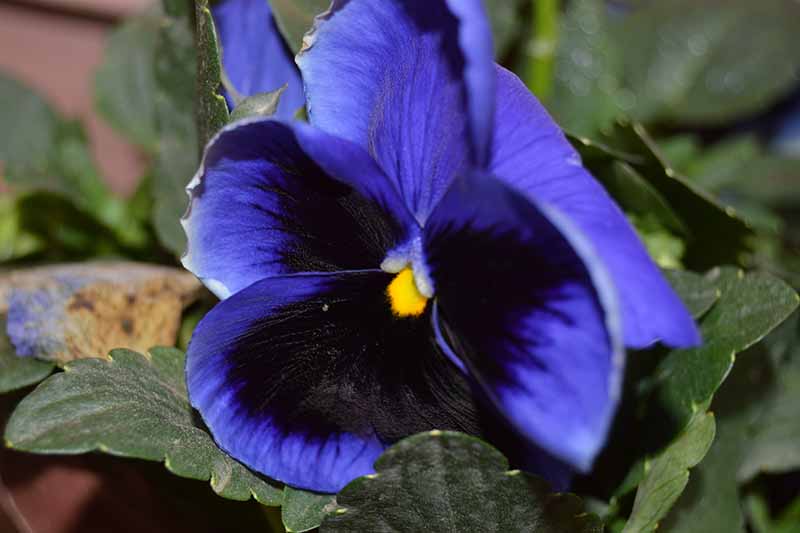
Also a biennial that blooms spring, summer, and fall, this plant grows four to six inches tall, with a spread of nine to 12 inches, and is suitable for growing in Zones 3-9.
Find packets of seeds in a variety of sizes at Eden Brothers.
14. Yellow Blotch
For a sunny faced pansy that’s sure to warm your heart, plant ‘Yellow Blotch’ (V. x wittrockiana).
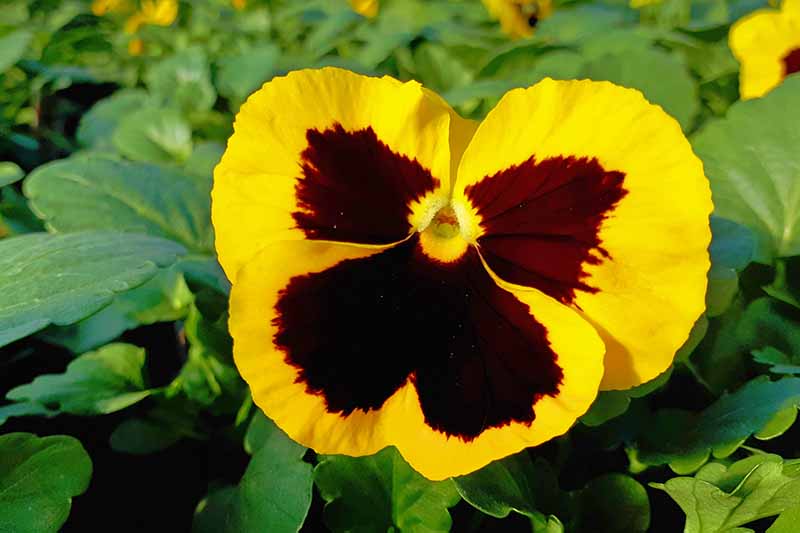
With a cheerful brown blotch in the center, this 9- to 12-inch tall variety is a happy addition to a walkway or window box.
This annual is especially well suited to container growing with its 9-12 inch spread.
The plant is hardy to Zones 5-10, and you can find a set of four plants at Burpee.
Violas
Sweet and small, violas will delight you with their solid, bicolor, and tricolored petals.
Like pansies, seeds are best sown indoors for transplanting into the garden. They enjoy plentiful sunshine, and loose, well-draining soil.
15. Amber Kiss
These golden-orange beauties (V. cornuta ‘Amber Kiss’) have tidy one-inch blooms and a delightfully sweet fragrance.
They grow eight to 10 inches tall with a spread of six inches, and bloom for 10 lovely weeks.
You’ll get to enjoy these annuals from the springtime to early fall, where they make a nice autumn accompaniment to the larger ‘Halloween II’ pansy. They’re hardy to Zones 4-9.
Find packets of 35 seeds from Burpee.
16. Celestial Northern Lights
Northern Lights
Have you ever seen the Northern Lights dance in the sky? I have, and it’s an experience I won’t forget.
If you never have, don’t fret: ‘Northern Lights’ (V. cornuta) from the Celestial series will evoke feelings of watching the lights flit across the night sky.
series will evoke feelings of watching the lights flit across the night sky.

These flowers are electric purple with a striped yellow throat and the plants only spread one to two inches.
They love moist, well-drained soil and can tolerate both heat and cold.
They’ll bloom all the way from spring to fall, unless it gets too hot. Then, they’ll take a little rest to regroup under the hot sun and bloom once more come October.
These gorgeous flowers are hardy in Zones 5-10.
17. ColorMax
One of the most heat resistant hybrids available, the ColorMax series (V. x hybrida) is a large-blooming hybrid that comes in an assortment of vivid colors.
series (V. x hybrida) is a large-blooming hybrid that comes in an assortment of vivid colors.
You can find ‘Clear Orange,’ ‘Clear Yellow,’ ‘Clear Purple,’ ‘Icy Blue,’ ‘Lemon Squash,’ and various others.
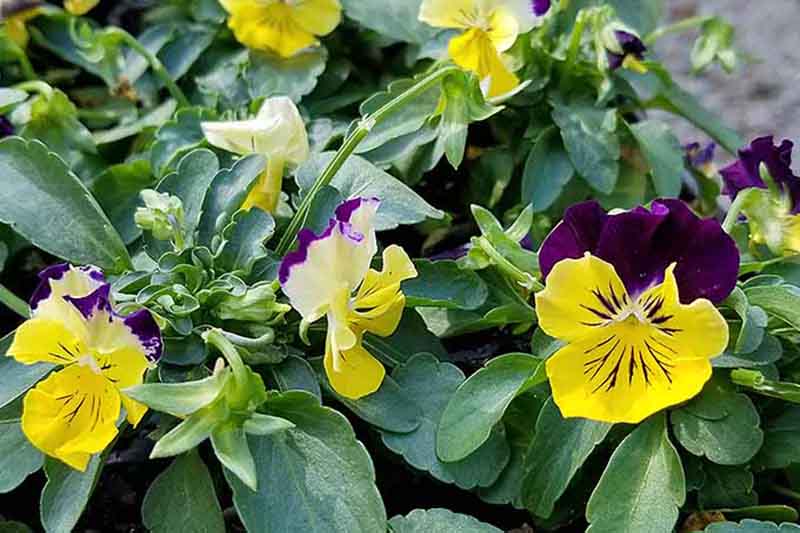
Plants in the ColorMax series are hardy to USDA Zones 5-9 but can withstand a bit of extra heat – and a bit of cold.
series are hardy to USDA Zones 5-9 but can withstand a bit of extra heat – and a bit of cold.
These annual cool-season violas thrive from November to May, spread eight to 10 inches, and reach four to six inches in height.
Plant together with chrysanthemums (How to Grow Chrysanthemums) in window boxes or garden walkways for a fall and early-winter pick-me-up.
18. Etain
Another favorite viola of mine is the lovely ‘Etain’ (V. cornuta). A sweet-scented bloom, this flower sports creamy-yellow leaves with pale purple edges and blooms from late spring to early summer.
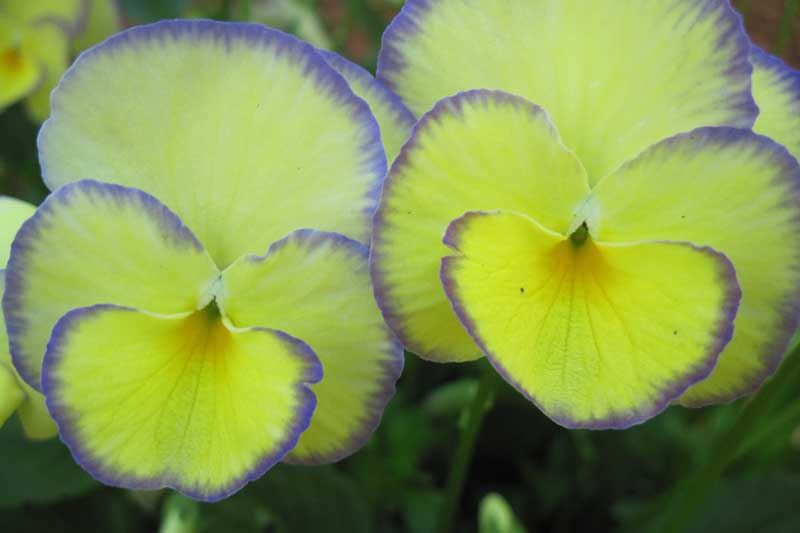
With a spread of six to eight inches and a height of the same, ‘Etain’ is a delicate cultivar to add to a pot or front walkway.
In fact, it’s one I’ll be adding to the flowerbeds in front of my house. The purple and yellow colors will go nicely with the rest of the perennials I’ve planted.

Hardy to USDA Zones 5-8, ‘Etain’ is a perennial that grows one to two inch blooms.
Flowers grow up to six to eight inches tall with a similar spread. And as a bonus, these violas are irresistible to butterflies and other pollinators.
19. Halo
For a gorgeous, deep-purple viola with a lighter purple and yellow center, try planting ‘Halo’ (V. cornuta).
A sweet-smelling perennial, ‘Halo’ acts as a nice groundcover, as it spreads 10-12 inches and grows eight to 10 inches tall.
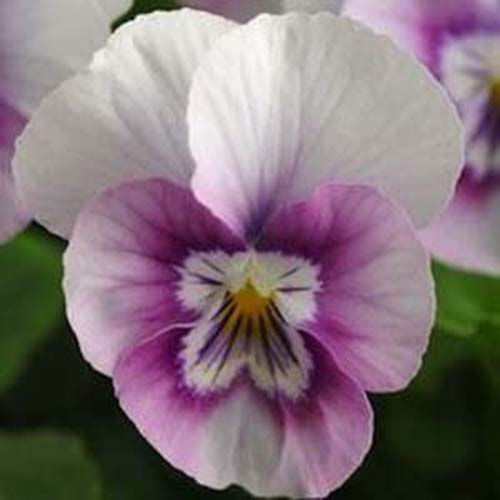
It’s hardy to Zones 5-9 and blooms from early spring all the way to the fall.
Plus, it’s deer (and moose) resistant so you don’t have to worry about your large mammalian visitors snacking on your flowers.
20. Halo Sky Blue
Just as lovely as its sister, ‘Halo,’ ‘Halo Sky Blue’ (V. cornuta) boasts a lighter blue-violet color with a pale center and yellow throat.
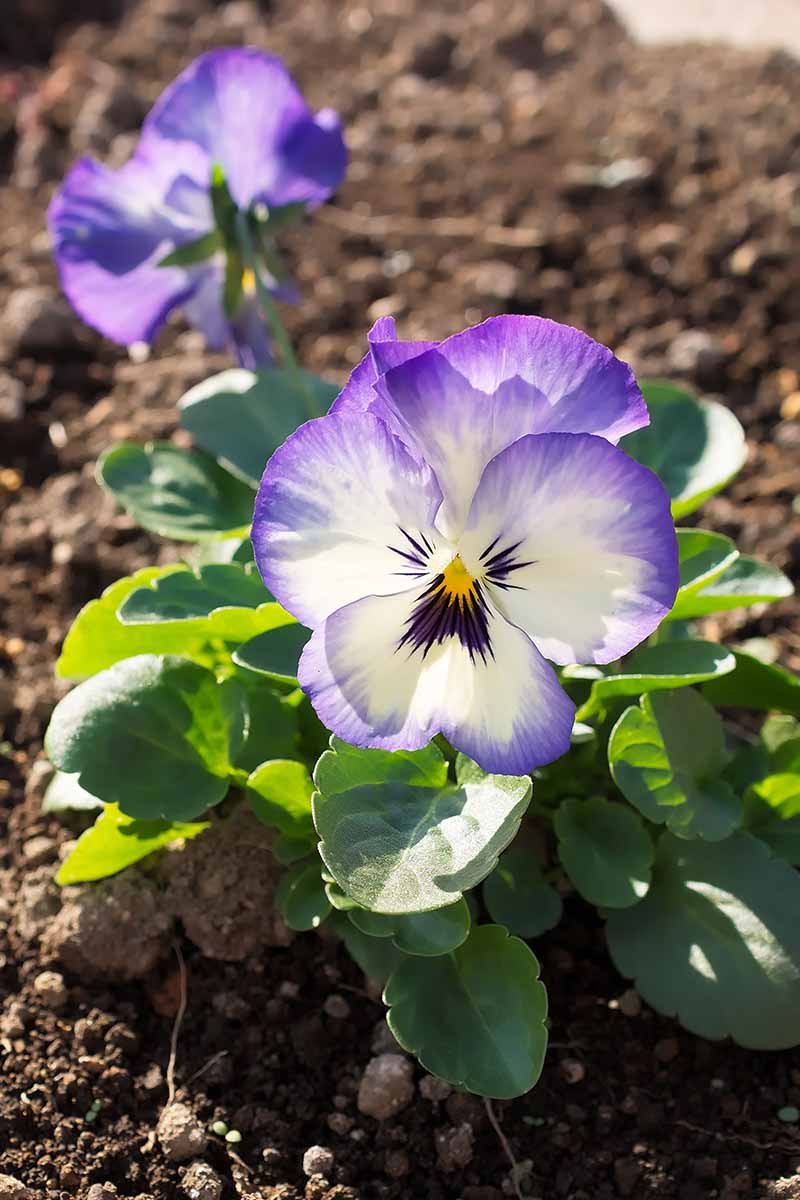
Sow seeds indoors in midwinter and transplant outdoors after ten weeks for striking blooms alongside deep red tulips.
This perennial is hardy to Zones 5-0, spreads 10 to 12 inches, and grows eight to ten inches tall. Plant in the spring or fall for twelve weeks of sweet-scented flowers.
21. Johnny Jump-Up
My first introduction to violas came during my childhood in Montana, when I measured spring’s welcome arrival each year by the flowers in our little walkway garden.
First, the daffodils. Then the tulips. And finally, the ‘Johnny Jump-Ups’ with their precious purple-yellow faces.
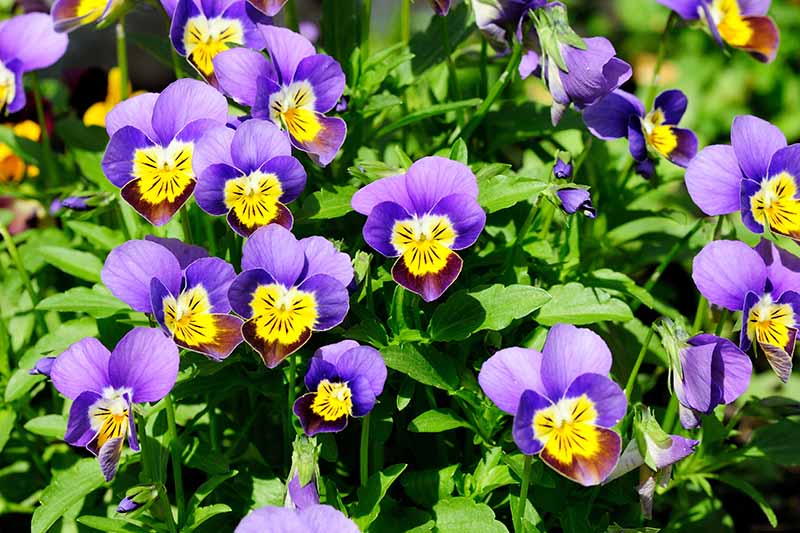
‘Johnny Jump-Up’ (V. cornuta) is a dainty perennial with purple, blue-white, and yellow petals.
Back in the day, these wildflowers would spring up in seemingly random places, earning them their adorable name.
‘Johnny Jump-Up’ blooms in the spring and summer and grows up to four inches tall. Ideal for colder climates, this plant is hardy to Zones 3-9 and spreads about six inches.
Find seeds at Eden Brothers.
22. King Henry
With a royal purple color on the outer part of its petals and a rich light purple in the center, ‘King Henry’ (V. cornuta) is a showstopper in any garden, windowbox, or pot.
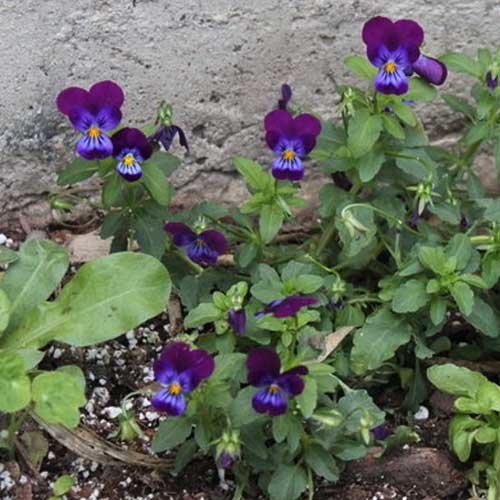
This cultivar grows six to eight inches tall with a spread of six to nine inches. It’s sometimes called ‘Horned Violet.’
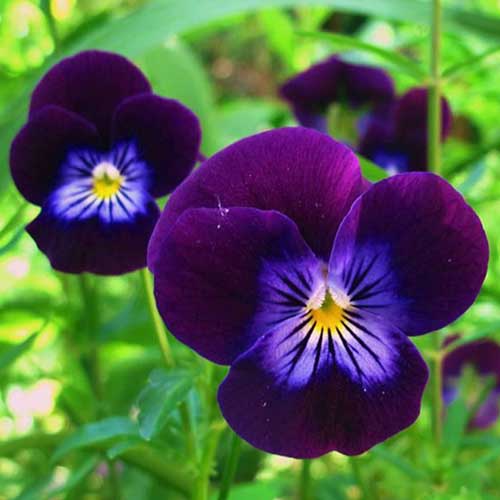
Grow ‘King Henry’ in Zones 6-9 for continuous blooms in the spring, summer, fall, and even winter in milder climates.
You can get seeds from Seed Needs via Amazon.
23. MagnifiScent® Sweetheart
Possibly one of the most sweet-scented violas available, MagnifiScent® ‘Sweetheart’ (V. x hybrida MagnifiScent® ‘Sweetheart’) looks a bit like ‘Etain’ with its purple edges, but with more creamy color and fuller ruffles.
And boy, do I love ruffled violas!
These dainty blooms are only one and a half inches wide, but they grow up to nine inches tall with a similar spread.
These annual flowers are hardy to Zones 5-8.
You can find a set of four plants from Burpee.
24. Sorbet Denim Jump Up
Purply blue, similar to ‘Johnny Jump Up,’ but with more light purple and some dark purple blotches on the edges of the petals, ‘Sorbet Denim Jump Up’ (V. cornuta) is a pleasing perennial for any garden.
This variety grows low to the ground and self-sows abundantly, offering a perfect groundcover for a flowerbed.
Growing to about six inches tall with a spread of up to eight inches, ‘Sorbet Denim Jump Up’ blooms for twelve weeks from spring to early fall and is hardy in Zones 3-8.
This is another ideal viola for those of us who live in chillier states.
You can find a set of four plants available from Burpee.
25. Tiger Eye
This incredibly striking viola is golden-orange with black stripes – just like a tiger.
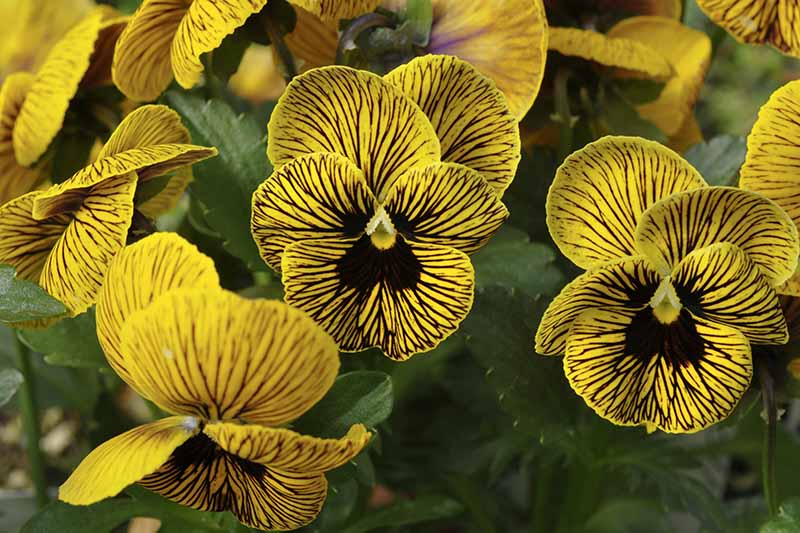
It makes an excellent pairing for ‘Halloween II,’ or a perfect addition to a garden that needs some extra pop to it.
Growing up to seven inches tall with a similar spread, ‘Tiger Eye’ is a compact variety.
It’s a perfect cultivar to plant in a pot and give to a friend in need of courageous, daring bloom.
Find packets of 35 seeds or a set of four plants from Burpee.
26. White Perfection
With a light fragrance and a color that’s wedding-dress white, ‘White Perfection’ (V. cornuta) makes a delicate statement in your flowerbed.

This biennial is hardy to Zones 5-9 and grows up to eight inches high with a six- to eight-inch spread.
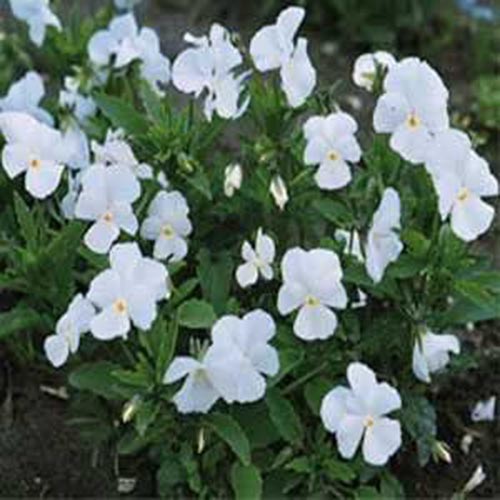
They’ll bloom all the way from spring to fall and attract butterflies and other pollinators.
You can find seeds available from Outsidepride via Amazon.
Species Violets
There’s nothing like stumbling upon a clump of violets during a walk through the forest. These species varieties make for excellent pressing flowers, and form bewitching carpets under and around the trees in your yard.
Some varieties can be difficult to find, but below you’ll discover several you can sow indoors and transplant outdoors for a gorgeous spread of Shakespeare’s faithfulness and steadfastness.
27. Appalachian Blue
Native to the wilds of Pennsylvania, West Virginia, Maryland, and North Carolina, ‘Appalachian Blue’ (V. appalachiensis) is a tiny flower with smooth leaves, slim petals, and a light, bluish-purple color.
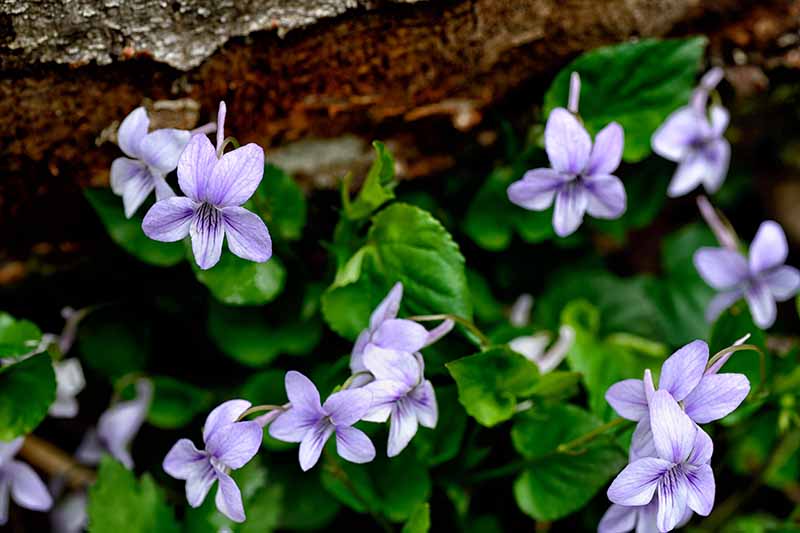
This mat-forming violet makes for a pleasing groundcover under trees and in open meadows.
It’s actually an imperiled wildflower, so if you find one out in the wild, don’t pick it!
‘Appalachian Blue’ grows in rich, moist soil and is hardy to Zones 5-8.
28. Beckwith’s Violet
With maroon top leaves and lighter purple or blue bottom leaves, ‘Beckwith’s Violet’ (V. beckwithii) makes for a striking sight.
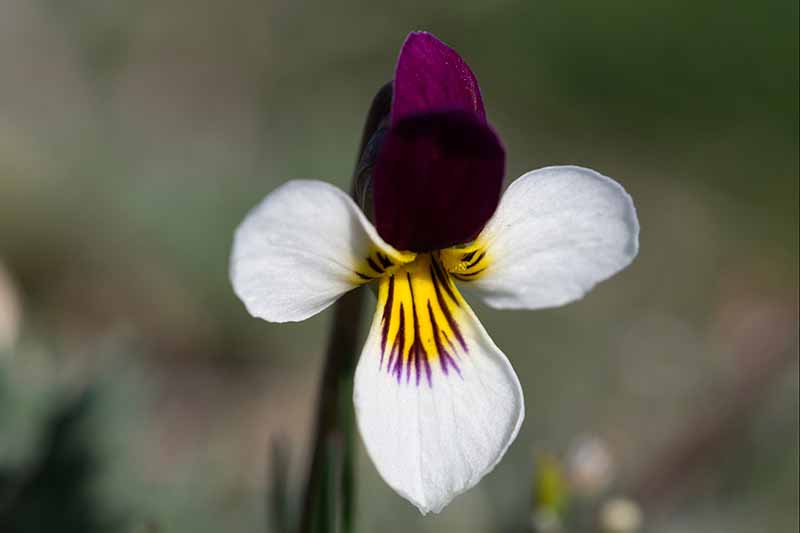
‘Beckwith’s Violet’ is native to the Pacific Northwest and grows well in rocky soil at mid to high elevations. It flowers in the early spring and sports thin, spiky leaves.
Depending on where it’s situated and how much sunlight it gets, the flower can grow anywhere from two to 20 inches tall. It’s hardy to Zones 5-10.
29. Bird’s Foot
With evenly-spread, slightly rounded petals, ‘Bird’s Foot’ (V. pedata) really does resemble its namesake.
The upper two petals tend to be smaller than the lower three, and the leaves are thin and spiky.
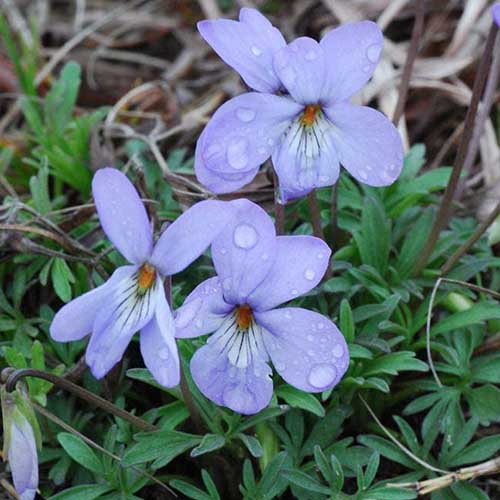
‘Bird’s Foot’ grows anywhere from four to ten inches tall and blooms in the spring and early summer and is hardy to Zones 4-9.
Find seeds to add this lovely, light-purple wildflower to your garden now on Amazon.
30. Bog White
With spear-shaped petals ‘Bog White’ (V. lanceolata var. lanceolata) is a pretty wildflower found in bogs, marshes, and floodplains across much of the USA and Canada.
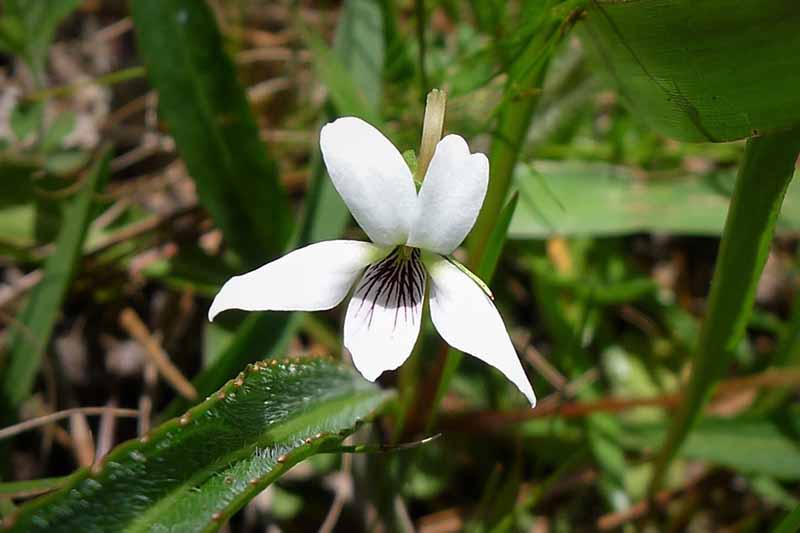
And of course, wet, squishy soil is its preferred growing ground, so don’t try to plant this one if you live in an arid area.
With its narrow, pointed petals and long, pointy leaves, it’s also referred to as the ‘Lanceleaf Violet.’ Blooms are white with a striped, lightly purple throat.
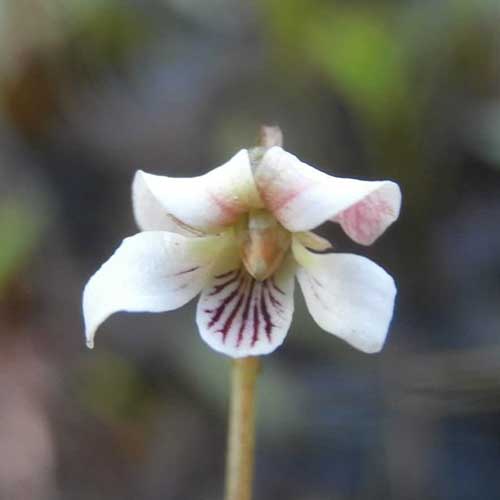
If you live in a marshy or extra-rainy area, you can plant this violet yourself and enjoy its dainty presence in your yard or garden.
It’s hardy to Zones 3-9 and you can find packets with 30 seeds available on Amazon.
31. California Golden
The ‘California Golden’ (V. pedunculata) violet was once an important food source for the Diegueno and Luiseno indigenous peoples of California.
They’d harvest the leaves before flowers appeared and cook them as nutritious greens.
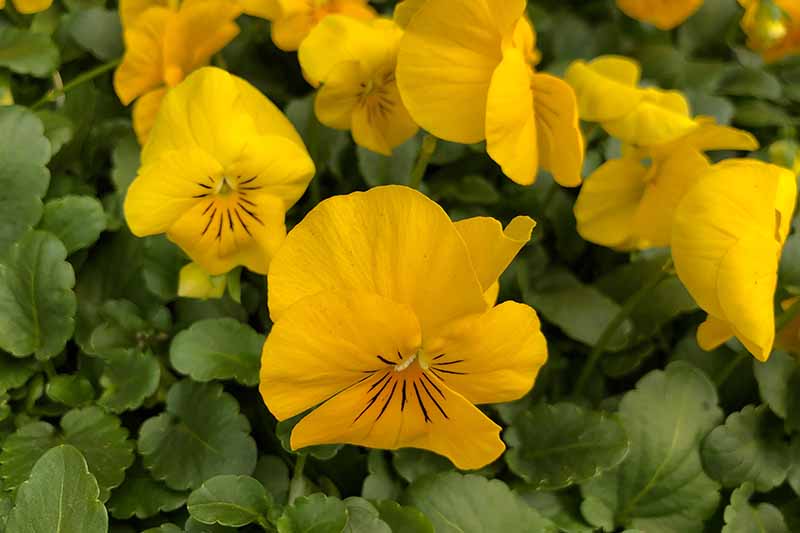
Head to California’s rolling hills and open meadows to spot these golden violets with their wide, yellow petals and pin-striped throats.
These flowers grow up to six inches high and bloom from February through April in California and other western states.
True to California fashion, they thrive in warmer weather and are hardy to Zones 7-10.
32. Canadian White
Mostly white with light purple shades on the outer part of its petals, ‘Canadian White’ (V. canadensis) is a sweet wildflower that blooms from April to July.
It features a yellow, dark-striped throat and thrives in shady forests, growing up to sixteen inches tall.
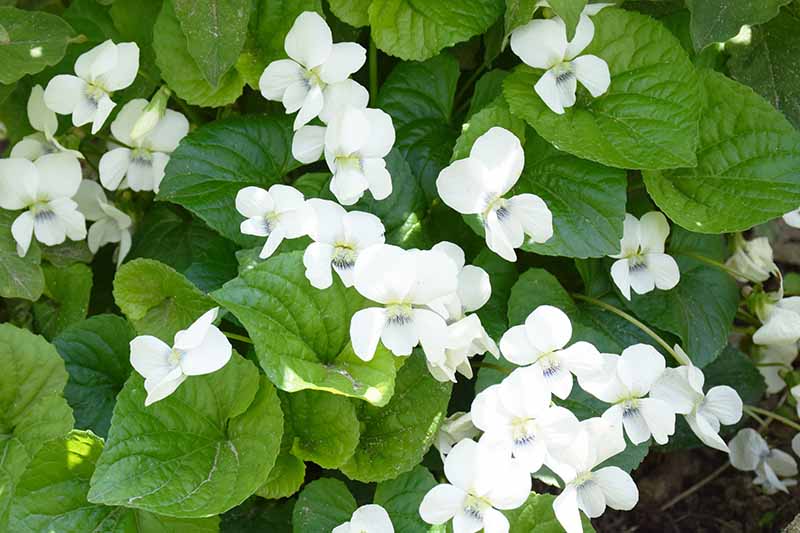
One distinguishing factor? Its side petals are often lightly tufted. Hardy to Zones 3-8, they’re native to much of Canada, as well as the northern states, such as Minnesota and Illinois.
You’ll see them in little clumps growing along the edge of forests.
33. Common Blue
This alluring violet, ‘Common Blue’ (V. sororia), features medium purple-blue petals with a white throat and blooms in the wilds of the eastern United States in mid to late spring.
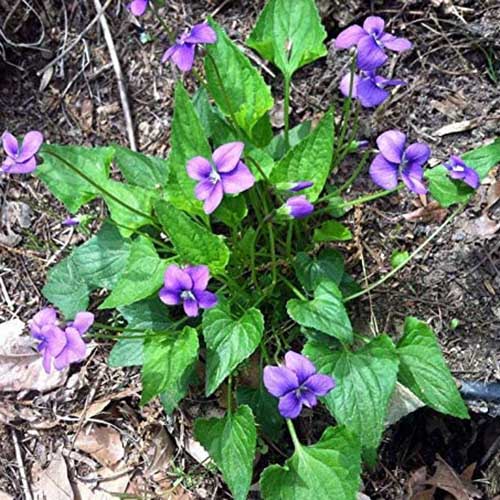
It doesn’t have any prominent scent, but it’s gorgeous enough that it doesn’t matter.
‘Common Blue’ grows up to four inches high with a six-inch spread, making it ideal to sow with other delicate wildflowers.
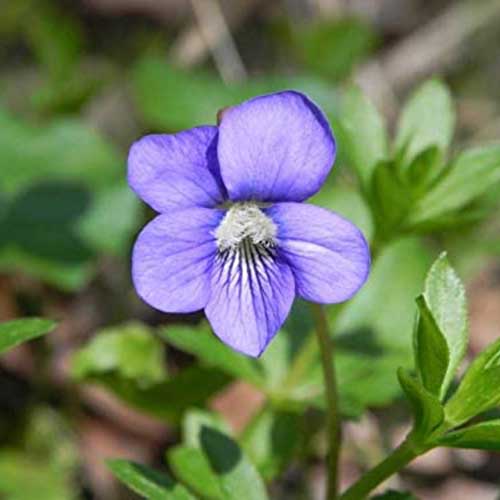
It’ll bloom year after year, sparking happiness in you every March or April.
These violets are hardy to Zones 4-8. You can get seeds from EdenWilds via Amazon.
34. Common Dog-Violet
It’s possible that you’ve spotted ‘Common Dog-Violet’ (V. rivininia) somewhere in nature. This plant is prolific in the wild across a lot of the temperate world.
It loves prairies and pastures, forests and wetlands. It doesn’t smell like much, but the beautiful heart-shaped leaves and delicate blue-purple flowers make up for it.
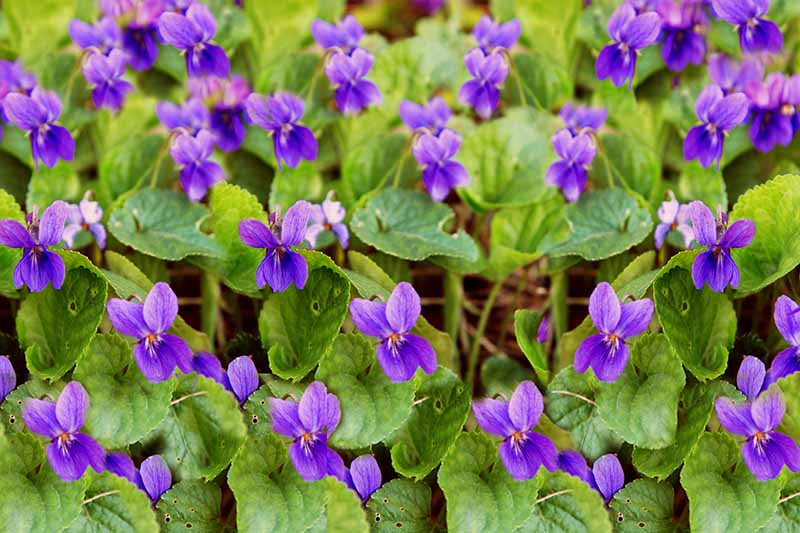
Plus, ‘Common Dog-Violet’ is an important breeding ground for fritillary butterflies: they use the leaves and leaf litter of the violets as cozy spots to lay their eggs.
This violet grows two to eight inches tall and forms small clumps. The flowers pleasantly nod off the stems, bobbing in light breezes, and are hardy to Zones 5-8.
35. Downy Yellow
This slightly hairy yellow beauty, ‘Downy Yellow’ (V. pubescens) grows nine to 12 inches tall and blooms in May and June.
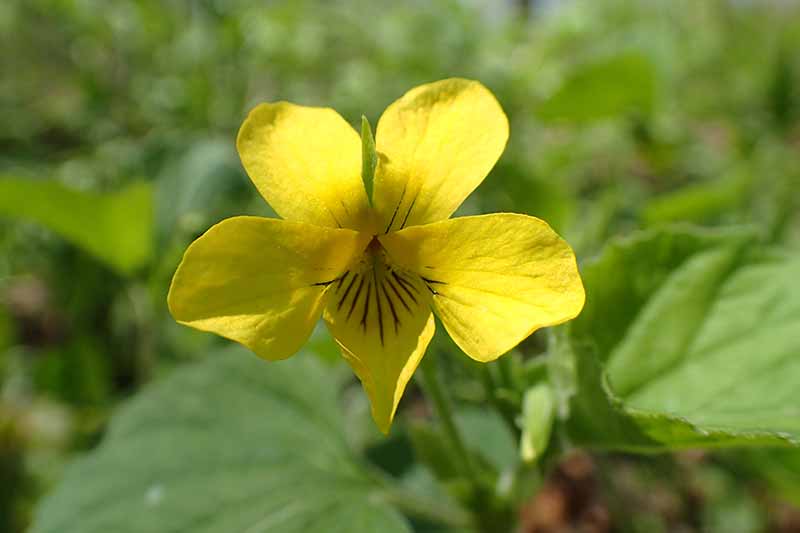
The leaves are a lot bigger than the flower, which produces a dramatic, yet delicate effect.
‘Downy Yellow’ loves rich dry soil (like prairie soil) with medium moisture, and grows well in Zones 3-8.
Which makes sense, since it is native to many different regions across Canada and the US.
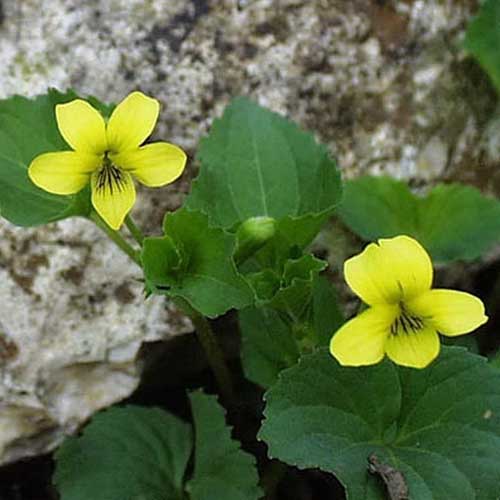
You can have this little drop of sunshine in your yard, too! Find seeds today available on Amazonavailable on Amazon.
36. Freckles
This fun violet looks like a sun-loving, freckled face. ‘Freckles’ (V. sororia) is native to eastern North America and features light blue flowers freckled all over with darker blue spots and splotches.
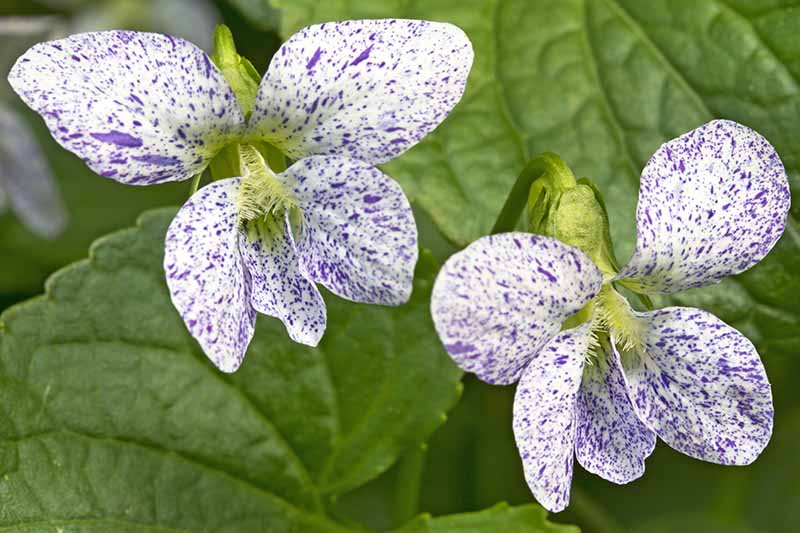
It flowers in the spring and summer, and you can plant it alongside daffodils for a delightfully sunny and cheerful early spring look.
‘Freckles’ is hardy to Zones 4-8 and prefers moist soil and sunshine.
The violet will grow six to eight inches tall and spread six to twelve inches wide.
37. Labrador
A delicate, pale-violet bloom, ‘Labrador’ (V. labradorica) is a low-growing flower that doesn’t grow more than four inches in height.
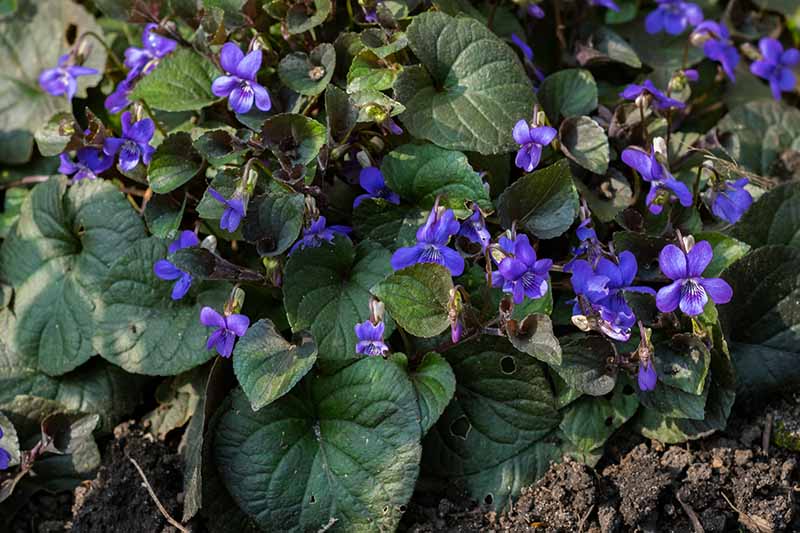
It thrives in Zones 3-7, which is good news for those of us in colder areas, and is native to Canada and the northern United States.
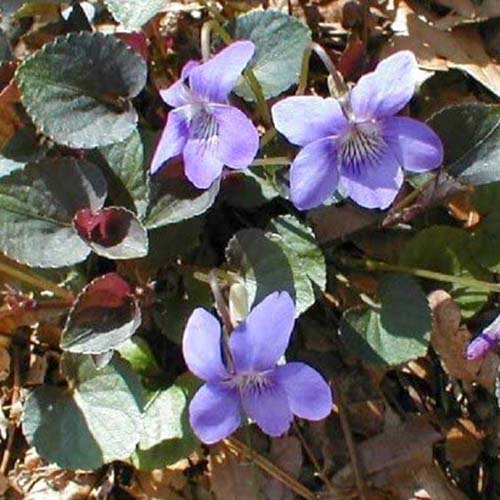
With a short blooming season (mid to late spring), this is one you get to enjoy briefly. But you’ll cherish every second!
Get packets containing 30 seeds today from Hirt’s Gardens via AmazonHirt’s Gardens via Amazon.
38. Prairie
A delicate purple violet that can grow anywhere from three to six inches tall, ‘Prairie’ (V. pedatifida) is hardy to Zones 3-8 and features nicely lobed petals.
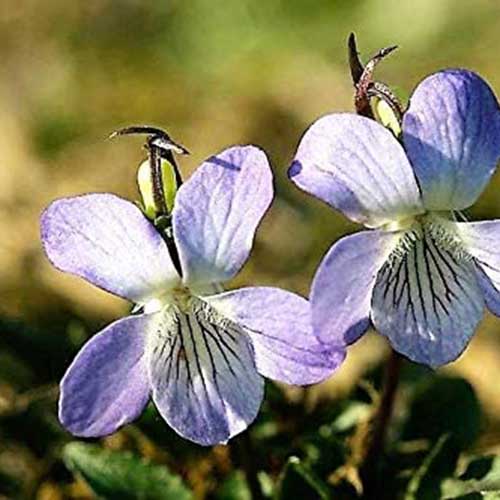
Thriving in slightly dry soil, this flower blooms from mid to late spring and is found – you guessed it – in North American and Canadian prairies.
Plant it in your own garden, too! You can get seeds from Sala Garden via Amazon.
39. Sweet Violet
Out of all the wildflower varieties of violets, ‘Sweet Violet’ (V. odorata) has the sweetest scent of all.
Plus, this one multiplies by runners, just like a strawberry. Its petals are a deep blue-purple, and it blooms from late winter to early spring for a true pick-me-up.
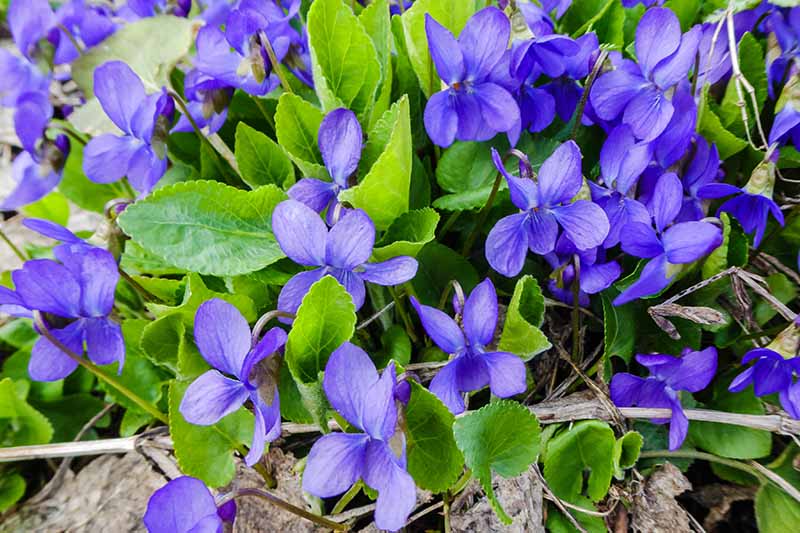
‘Sweet Violet’ grows six to 10 inches tall with a spread of 12 to 18 inches. It loves moist, well-drained soil and is hardy to Zones 5-9. In Zones 7 and up, you’ll get buds and flowers all winter long.
Lucky you!
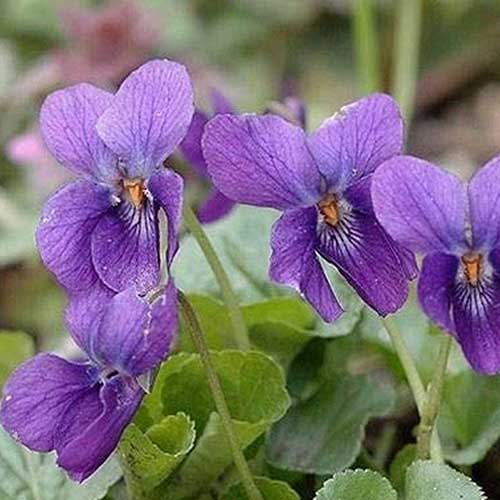
‘Sweet Violet’ may be native to Europe, but you can grow it at home, too.
Get seeds now from Flowelover via Amazon.
Extra Bonus Mixes
Need a few more ideas for your viola garden? Can’t decide which variety to choose? Check out these three bonus mixes.
Colossus Mix
With whopping four- to five-inch blooms, this Colossus Series Mix (V. x wittrockiana) of annuals features bold white, yellow, purple, blue, and rose petals with dark blotches in the center.
Series Mix (V. x wittrockiana) of annuals features bold white, yellow, purple, blue, and rose petals with dark blotches in the center.
These pansies thrive in moist, well-drained soil, bloom 91-98 days after sowing, and are hardy to Zones 4-10, so practically anyone can grow them.
For a colorful summer pick-me-up, you can’t beat the Colossus Series Mix.
Series Mix.
Find packets of seeds in a variety of sizes from True Leaf Market.
Pansy Seeds Mix
For a classic mix of pansies that can’t be beat, try this heirloom Pansy Seeds Mix.
With colors in purple, white, and yellow and an extra level of cold hardiness (Zones 3-9), you’ll enjoy these flowers all summer long.
They grow three to five inches tall and spread about the same amount. Best of all? They’re perennials, coming back to your garden year after year.
Find seed packets online at Eden Brothers.
Sorbet Series
For a series of violas that will make your mouth water with their alluring color, try the Sorbet Series.
You can pick your favorite color – I chose ‘Lilac Ice’ and my seedlings are growing nicely – and plant them in a window box or front garden for perennial color and cheer.
Since these are hardy to Zones 3-9, they’re perfect for Alaskans like me. They spread eight to 10 inches and grow up to eight inches tall for an eye-pleasing mound.
Find your favorite color at True Leaf Market.
Faithful Violets for Your Garden
No matter who you are, faithful, cheerful, and loving violets will warm your soul.
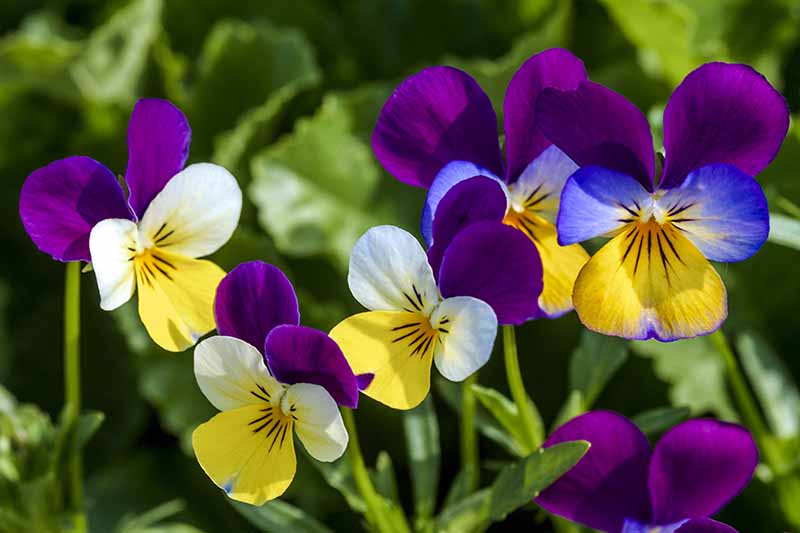
Blend different varieties together for a show-stopping display that will garner praise from everyone who passes your garden.
Have you ever planted violets? Which ones are your favorites? Let us know in the comments below.
And if you need more information about growing flowers in your garden, you’ll need these guides next:
- How to Plant and Grow Lilies
- How to Grow and Care for Tulips
- How to Grow and Care for Sky Blue Aster
Photo by Matt Suwak © Ask the Experts, LLC. ALL RIGHTS RESERVED. See our TOS for more details. Product photos via Amazon, Burpee, Eden Brothers, EdenWilds, Flowelover, Hirt’s Gardens, Outsidepride, Park Seed, Sala Garden, Seed Needs, and True Leaf Market. Uncredited photos: Shutterstock. With additional writing and editing by Allison Sidhu and Clare Groom
The post 39 of the Best Violet Varieties appeared first on Gardener's Path.


